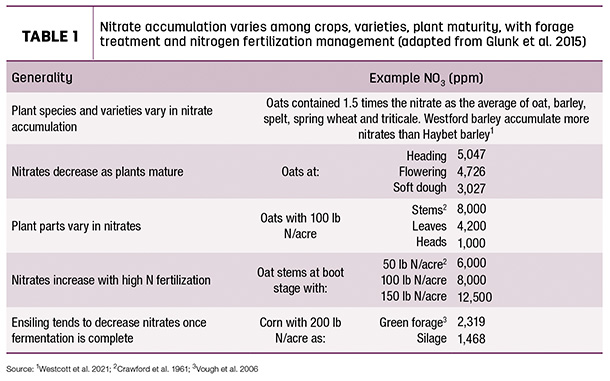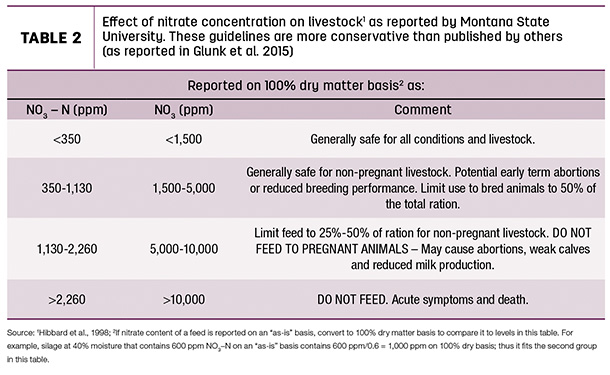Livestock producers are often confronted with how to feed high-nitrate forages. The concern with nitrate consumption by livestock is the rapid conversion of nitrate to nitrite in the rumen. Once converted, excessive nitrites are then absorbed into the bloodstream and bind with hemoglobin to produce methemoglobin, which can result in a range of health issues in livestock, namely early-term abortions and/or reduced breeding efficiency.
Causes of high nitrates
Nitrates (NO3) can accumulate to toxic levels in many forage crops. High nitrates have been recorded in both cool-season annuals (i.e., oats, rye, wheat, barley, triticale, spelt, etc.) and warm-season annuals (i.e., sorghum, sudangrass, millet, corn) as well as perennial forage species like bromegrass, orchardgrass, fescue, sweetclover and alfalfa. Additionally, many of the plant species in the goosefoot family (Chenopodiaceae) are common annual weeds cultivated in the western U.S. and also are considered high-nitrate-accumulating plants. Some common members of the goosefoot family are kochia (Kochia scoparia), Russian thistle (Salsola iberica) and lamb’s-quarters (Chenopodium berlandieri).
First reported in 1895, livestock poisoning from plant nitrates has since been realized as a common occurrence and concern for livestock producers. More accurately termed nitrite (NO2) poisoning, the condition and associated losses were common in the 1930s when large acreages of drought-stricken oats were harvested and fed to livestock as forage.
Nitrate alone is not toxic to animals, and in the rumen nitrate is broken down to nitrite and then typically to ammonia (NH3). However, when forages contain excessive levels of nitrate, the rumen becomes overwhelmed, and much of the nitrate is not fully processed into ammonia Instead, the intermediate product, nitrite, enters the bloodstream through the small intestine. Hemoglobin carries oxygen in the bloodstream; however, when it binds with nitrite, methemoglobin is formed, which reduces or even stops oxygen transport in the body.
This low oxygen supply can have many negative effects in livestock, and the severity of animal poisoning is often a combination of the nitrate level and duration of exposure. Chronic toxicity results from animals consuming small amounts of high-nitrate forages for longer time periods, while acute toxicity results from animals consuming large amounts of high-nitrate forages in a short time period.
Managing growing conditions
All plants contain detectable amounts of nitrate, and under normal growing conditions, nitrate is quickly converted to protein when adequate sunlight energy is available. The accumulation of nitrate in plants occurs when uptake from the soil exceeds plant photosynthetic use for protein synthesis. Many factors contribute to the accumulation of plant nitrates, and producers and agricultural advisers need to be aware of these conditions when they occur during forage production.
Stressed growing conditions are one of the most significant factors contributing to nitrate accumulation in forage plants. Stressed conditions include drought, frost, hail, excessive shading, low temperatures, herbicide damage, soil nutrient and mineral deficiencies, and damage from pest insects and/or diseases. Nitrate accumulation varies by crop and crop variety, forage management, soil fertility, plant part and plant maturity (Table 1).

Plant species vary in their ability to accumulate nitrates, and even different varieties of cereal forage crop will exhibit differences. Selecting crops and cultivars that have a lower accumulation potential can help reduce toxicity levels. Also, consider environmental growing conditions for each year separately, and adjust inputs accordingly. Additionally, forage crops grown in soil with excessive nitrogen fertilization are suspect for nitrate accumulation.
Additionally, phosphorous, potassium and sulfur soil deficiencies will often lead to excessive nitrate accumulation in plant tissue, while sufficient levels will aid plants in converting nitrates to proteins, resulting in lower total accumulations. A good practice is soil sampling and amending soil nutrient profiles according to laboratory results, which results in proper soil and plant nutrient balances and efficient plant photosynthetic capabilities.
Good preventative forage-production practices will aid in reducing plant nitrate accumulations. In general, test soils and apply all fertilizers according to lab results. Control nitrogen-accumulating weeds in forage fields, use alternative cereal forages with high water-use efficiencies (winter and spring cereals) and in Northern climates, cool-season cereal forages can be grown and harvested often before hail, drought or frost conditions occur.
Harvest management
If any of the above conditions occur during the growing season, those forages should be suspect for nitrate accumulation, and precautions should be taken before feeding. Plant nitrate levels are highest in the morning, so harvest and/or grazing should be avoided during this time, especially with fields suspected of high nitrate accumulations. Instead, delay harvest until the afternoon on warm sunny days to give plants the time needed to process any excessive nitrates accumulated during nighttime.
Lower portions of the plants (i.e., roots and stalks) accumulate the highest levels of nitrates followed by leaves and then grain. Elevating the cutting bar at harvest above the lower one-third of the plant stalk will help reduce the harvested nitrates in baled forages.
Nitrates are often reduced in more mature cereal forages, and levels can often be reduced by delaying harvest from stem elongation and flowering until the soft dough stage (Table 1). However, there is a trade-off as more mature forages will have reduced crude protein and increased ADF and NDF values.
During drought conditions, certain fields may receive a drought-ending rain. Under these conditions, producers should wait approximately one week before harvesting or grazing, allowing plants sufficient time to process any accumulated nitrates.
General practices worthy of consideration are to both anticipate and test for nitrates before, during and following any growing season stresses. Conditions such as frost, drought, insect damage, etc. can and often do results in nitrate accumulation, so identifying these events and testing forage will allow producers to harvest and stack hay in lots, according to nitrate levels. This will allow producers to feed out hay knowing the nitrate levels and to blend those forages with excessively high-nitrate levels.
Crimping forage crops during harvest will improve drydown time and will also accelerate nitrogen volatilization, often giving off nitrogen-based gas and denitrifying the hay prior to baling. When feeding, nitrate toxicity often occurs when animals are pastured or fed greenchop followed by hay. Preserving forages as silage, haylage or balage will often result in nitrate reductions of 10% to 60% due to fermenting microbes converting forage nitrates to ammonia. In traditional dried hay bales, nitrate levels are typically very stable and remain very close to the levels recorded at harvest. Harvested forages should always be tested before feeding to livestock (Table 2).

Grazing high-nitrate forages
When allowing livestock to harvest their own forage in stockpiled forage or crop residue fields, several guidelines will help minimize any associated risks. First, grazing animals typically eat at a slower rate than in a situation with harvested feeds. This will help reduce the rate of nitrate accumulation in the animal and subsequent issues with toxicity.
Grazing animals typically select plant leaves and heads first, which contain substantially fewer nitrates than plant stems (Table 1). Animals should not be stocked at high densities or strip grazed, as this will increase the intake amount and the consumption of higher-nitrate stem material.
In Nebraska, cattle were allowed to graze brassica forage mixes with whole-plant nitrate levels between 17,720 and 35,440 part per million (ppm) without detrimental effects associated with nitrate toxicity. Cattle were lightly stocked and allowed to graze fresh high-moisture forage, which further reduces nitrate release by the plant.
Animals grazing high-nitrate fields should be fed in the morning with low-nitrate hay before being released onto high-nitrate stockpiled forages. This will slow down the animal intake rate and help to minimize toxicity issues. The key to this strategy is gradual adaption of the rumen to the high-nitrate forages. Keeping the animals mostly full of low-nitrate forages while slowly increasing the high-nitrate portion of the diet will aid in increasing rumen bacteria capable of converting nitrate to ammonia. Adapted animals can graze higher-nitrate forages with lower risk.
Producers can also blend high-nitrate forages with other feedstuffs to achieve lower total nitrate levels in a quantity of feed and allow animals access to unlimited, high-quality and low-nitrate water.
Finally, producers can consider grain supplementation while feeding higher-nitrate forages. This strategy supplies needed energy to rumen microbes to successfully convert high levels of plant nitrate into bacterial protein. Many cover crops with high levels of brassicas (i.e., turnips and radishes) are highly digestible and may, by themselves, provide sufficient energy to rumen microbes and eliminate the need for grain supplementation.
Summary
Judicious use of fertilizers and an awareness of factors inducing plant stress combined with good livestock management can help reduce losses from nitrate poisoning. Producers should always test forage nitrate levels with a certified lab before feeding. With a nitrate analyses, producers should also request forage nutritive estimates, which are useful when balancing winter rations.
Hayes Goosey is an assistant professor of Forage, Agronomy and Entomology at Montana State University. Email Hayes Goosy.










